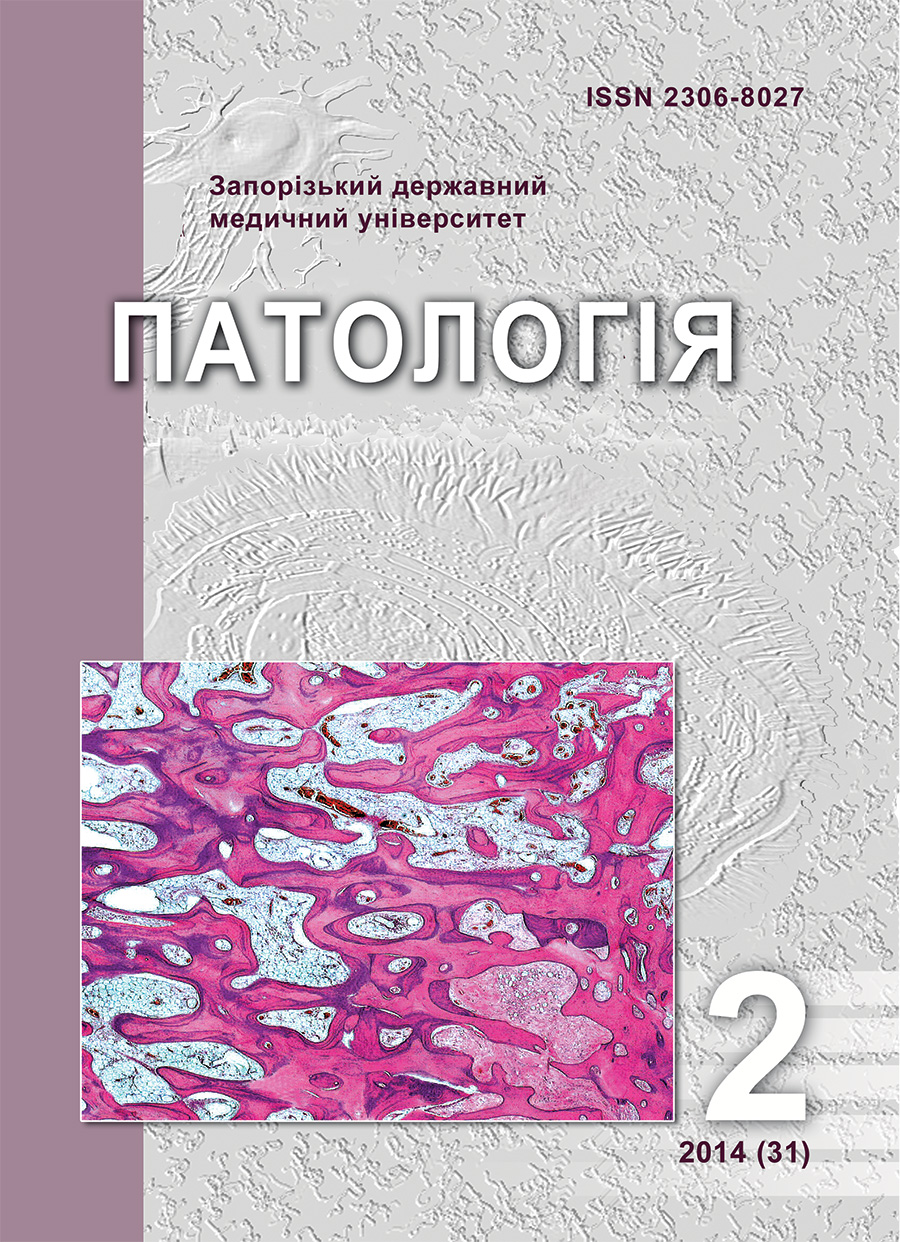Features of bacterial-mycotic dysbiosis in women with high oncogenic risk human papillomavirus suffering from cervicitis, erosion and cervical dysplasia
DOI:
https://doi.org/10.14739/2310-1237.2014.2.28548Keywords:
Microbiota Vagina, Papillomaviridae, Cervicitis, Cervix Erosion, Cervix DysplasiaAbstract
Aim. A possible relationship between the uterine neck dysplasia and vaginal microbiocenosis has been subject for broad discussions for many years. Hence, research devoted to the study of the problem of cervical lesions, in particular the progression of cervicitis, cervical erosion and cervical dysplasia depending on the ratio of obligate, opportunistic pathogenic and pathogenic microorganisms is of particular importance and relevance today.
Methods and results. To address the problem, we have conducted a complete examination and studied the peculiarities of the opportunistic and pathogenic microflora spectrum in the urogenital tract microbiota in case of 120 female patients of reproductive age suffering from cervicitis, cervical erosion or cervical dysplasia on the background of Papilloma Viral Infection. The control group included 30 apparently healthy women.
Conclusion. It was set, that dysbiosis forms in 52,1% women, in this 38,8% patients have moderate and 13,3% patients have severe dysbiosis. Anaerobic type of dysbiosis was verified in 22,9% women and in 29,2% it was mixed aerobic-anaerobic type. Gardnerella vaginalis/Prevotella bivia/Porphiromonas spp., Eubacterium spp., Megasphaera spp./Veilonella spp./Dialister spp., Peptostreptococcus spp. were prevalent urogenital microbiota. Ureaplasma (urealiticum parva) was verified in 23,8% patients and diagnostically meaningful it was in 20,0%, Candida spp. was 64,6 and 54,6% accordingly.
References
Borgdorff, H., Tsivtsivadze, E., Verhelst, R., Marzorati, M., Jurriaans, S., Ndayisaba, G. F., Schuren, F. H., & van de Wijgert, J. H. (2014). Lactobacillus-dominated cervicovaginal microbiota associated with reduced HIV/STI prevalence and genital HIV viral load in African women. ISME Jour, 6, 38–44.
Smith, B. C., McAndrew, T., Chen, Z., Harari, A., Barris, D. M., Viswanathan, S., Rodriguez, A. C., Castle, P., Herrero, R., Schiffman, M., & Burk, R. D. (2012). The cervical microbiome over 7 years and a comparison of methodologies for its characterization. PLoS One, 7, 44–45.
Lazenby, G. B., Taylor, P. T., Badman, B. S., McHaki, E., Korte, J. E., Soper, D. E., & Young Pierce, J. (2014). An association between Trichomonas vaginalis and high-risk human papillomavirus in rural Tanzanian women undergoing cervical cancer screening. Clin. Ther, 1, 38–45.
Samoff, E., Koumans, E. H., Markowitz, L. E., Sternberg, M., Sawyer, M. K., Swan, D., Papp, J. R., Black, C. M., & Unger, E. R. (2005). Association of Chlamydia trachomatis with persistence of high-risk types of human papillomavirus in a cohort of female adolescents. Amer. Jour. Epidemiol, 7, 668–675.
Zheng, M. Y., Zhao, H. L., Di, J. P., Lin, G., Lin, Y., Lin, X., & Zheng, M. Q. (2010). Association of human papillomavirus infection with other microbial pathogens in gynecology. Zhonghua Fu Chan Ke Za Zhi, 6, 424–428.
Silva, C., Almeida, E. C., Côbo Ede, C., Zeferino, V. F., Murta, E. F., & Etchebehere, R. M. (2014). A retrospective study on cervical intraepithelial lesions of low-grade and undetermined significance: evolution, associated factors and cytohistological correlation. Sao Paulo Med. Jour, 2, 92–96.
Jahic, M., Mulavdic, M., Hadzimehmedovic, A., & Jahic, E. (2013). Association between aerobic vaginitis, bacterial vaginosis and squamous intraepithelial lesion of low grade, Med. Arh, 2, 94–96.
Murta, E. F. (2014). Chlamydia trachomatis, human papillomavirus, bacterial vaginosis and cervical neoplasia. Arch. Gynecol. Obstet, 6, 70–73.
Lie, A. K., Skjeldestad, F. E., & Hagen, B. (2005). Occurrence of human papillomavirus infection in cervical intraepithelial neoplasia. A retrospective histopathological study of 317 cases treated by laser conization. APMIS, 10, 693–698.
Oakeshott, P., Aghaizu, A., Reid, F., Howell-Jones, R., Hay, P. E., Sadiq, S. T., Lacey, C. J., Beddows, S., & Soldan, K. (2012). Frequency and risk factors for prevalent, incident, and persistent genital carcinogenic human papillomavirus infection in sexually active women: community based cohort study. Brit. Med. Jour, 344, 41–48.
Merckx, M., Benoy, I., Meys, J., Depuydt, C., Temmerman, M., Weyers, S., & Broeck, D. V. (2014). High frequency of genital human papillomavirus infections and related cervical dysplasia in adolescent girls in Belgium. Eur. Jour. Cancer Prev, 23(4), 288–293.
Rahman, T., Tabassum, S., Jahan, M., & Nessa, A. (2013). Detection and estimation of human papillomavirus viral load in patients with cervical lesions. Bangladesh Med. Res. Counc. Bull, 39(2), 86–90.
Aamri F., Remuzgo, S., Acosta, F., Real, F., Ramos-Vivas, J., Icardo, J. M., & Padilla, D. (2014). Interactions of Streptococcus iniae with phagocytic cell line. Microbes Infect, 14, 76–78.
Ankirskaya, A. S., & Murav'eva, V. V. (2005). Vaginal infections: laboratory diagnosis of opportunistic infections of the vagina. Consilium-medicum, 7(3), 26–28.
Glanc, S. (1998). Mediko-biologicheskaya statistika [Biomedical Statistics]. Moscow: Practica.
Downloads
How to Cite
Issue
Section
License
Authors who publish with this journal agree to the following terms:- Authors retain copyright and grant the journal right of first publication with the work simultaneously licensed under a Creative Commons Attribution License that allows others to share the work with an acknowledgement of the work's authorship and initial publication in this journal.

- Authors are able to enter into separate, additional contractual arrangements for the non-exclusive distribution of the journal's published version of the work (e.g., post it to an institutional repository or publish it in a book), with an acknowledgement of its initial publication in this journal.
- Authors are permitted and encouraged to post their work online (e.g., in institutional repositories or on their website) prior to and during the submission process, as it can lead to productive exchanges, as well as earlier and greater citation of published work (SeeThe Effect of Open Access).

